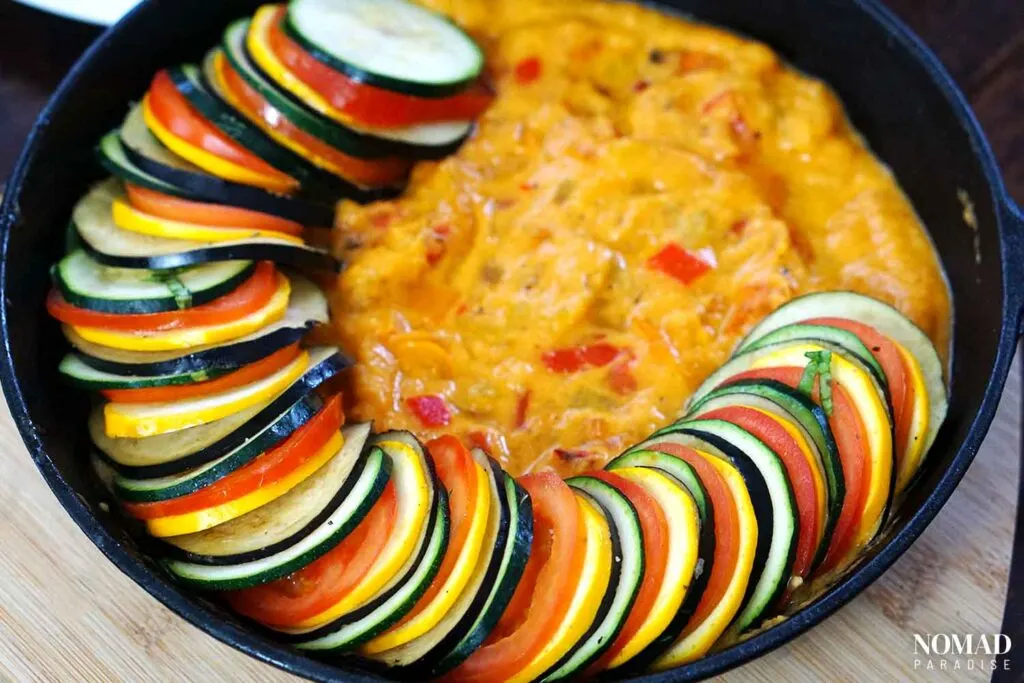French cuisine, renowned for its elegance and sophistication, is a tapestry of flavors that has captivated palates around the world. Among the many culinary gems that France has gifted to the global gastronomic scene, Ratatouille stands out as a vibrant and delicious representation of Provencal cuisine. In this article, we delve into the origins, ingredients, preparation, and cultural significance of the French Ratatouille, exploring why it has become a celebrated dish both in its homeland and beyond.

Culinary South Africa Traditional Foods
A Culinary Journey to Provence: The Birthplace of Ratatouille
Ratatouille originates from the sun-kissed region of Provence in southeastern France. Nestled between the Mediterranean Sea and the Alps, Provence is not only known for its picturesque landscapes but also for its rich culinary heritage. The word “ratatouille” is derived from the Occitan term “ratatolha” and the French verb “touiller,” meaning to stir or toss.
The dish is a celebration of the region’s bounty, featuring an array of vegetables that thrive in the Mediterranean climate. While the exact origin of Ratatouille is debated, it is widely acknowledged as a traditional Provençal dish that reflects the agricultural abundance of the area.
Ingredients: A Symphony of Fresh Vegetables and Aromatics
Central to the charm of Ratatouille is its medley of vibrant and fresh vegetables. While there are variations of the dish, the classic ingredients include:
- Eggplant (Aubergine): Adds a rich, meaty texture to the dish.
- Zucchini (Courgette): Offers a mild and slightly sweet flavor.
- Bell Peppers: Contribute sweetness and vibrant colors.
- Tomatoes: Provide a luscious base for the stew.
- Onions and Garlic: Add depth and aromatic complexity.
- Herbs de Provence: A fragrant blend of herbs like thyme, rosemary, oregano, and marjoram.
Olive oil, salt, and pepper are essential to enhance the natural flavors of the vegetables. The combination of these ingredients results in a harmonious blend of tastes, textures, and aromas that epitomize the essence of Provençal cuisine.
Preparation: Crafting the Artful Layers
The preparation of Ratatouille involves a meticulous layering of sliced vegetables, creating a visually stunning dish that mirrors the colors of the Provencal landscape. Here is a step-by-step guide to crafting this culinary masterpiece:
a. Slicing the Vegetables:
- Consistent Thickness: Ensure uniform thickness for even cooking.
- Artful Arrangement: Alternately layer slices of eggplant, zucchini, and tomatoes in a circular or overlapping pattern.
b. Building the Base:
- Tomato Sauce: Create a flavorful base by combining tomatoes, onions, garlic, and herbs. This can be a simple tomato sauce or a more elaborate concassé.
c. Drizzling Olive Oil:
- Essential Elixir: Generously drizzle olive oil over the layered vegetables, infusing them with the richness and fruity notes characteristic of Provencal olive oils.
d. Slow Roasting:
- Gentle Cooking: Roast the dish at a low temperature, allowing the flavors to meld and the vegetables to become tender. This slow cooking process is key to the development of Ratatouille’s distinctive taste.
e. Garnishing with Fresh Herbs:
- Finishing Touch: Sprinkle fresh herbs, such as basil or parsley, over the Ratatouille just before serving to add a final burst of flavor and aroma.
Istanbul’s Culinary Paradise of Street Food
Cultural Significance: More Than a Dish, It’s a Tradition
Ratatouille is not merely a dish; it is a reflection of the cultural and agricultural heritage of Provence. As a region blessed with an abundance of fresh produce, the people of Provence crafted Ratatouille as a way to showcase and celebrate the flavors of their land. This humble dish embodies the farm-to-table ethos, emphasizing seasonal and locally sourced ingredients.
Beyond its roots in traditional cuisine, Ratatouille gained international recognition through popular culture. The animated film “Ratatouille,” directed by Brad Bird, further elevated the dish to global acclaim. The movie’s protagonist, Remy the rat, creates a visually stunning Ratatouille dish that not only captivates the characters in the story but also inspired real-life chefs to recreate the iconic presentation.
Versatility: From Classic to Contemporary Interpretations
While the classic Ratatouille remains a timeless favorite, chefs around the world have embraced the dish and infused it with modern twists. Contemporary interpretations may include variations such as:
- Ratatouille Tart: Layers of Ratatouille arranged atop a flaky pastry.
- Ratatouille Lasagna: Incorporating the vegetable medley into layers of lasagna sheets.
- Grilled Ratatouille: Vegetables grilled to perfection, offering a smoky flavor.
The adaptability of Ratatouille highlights its versatility, making it a staple in both traditional and innovative culinary landscapes.
Savoring the Experience: Ratatouille and the Art of Slow Food
Beyond its delectable taste, Ratatouille embodies the philosophy of slow food—an approach to cooking and dining that values locally sourced, seasonal ingredients and emphasizes the pleasure of shared meals. The process of slow roasting and layering the vegetables is a testament to the idea that good food takes time, care, and attention.
Savoring Ratatouille is not just about the flavors on the plate; it’s about relishing the experience of preparing and sharing a meal with loved ones. The communal aspect of enjoying Ratatouille aligns with the French tradition of appreciating meals as moments of connection and conviviality.
Embracing Ratatouille: A Culinary Journey to Provence
In conclusion, Ratatouille is more than a dish—it’s a culinary journey to the sun-drenched landscapes of Provence. From the careful selection of fresh vegetables to the artful layering and slow roasting, each step in the preparation of Ratatouille is a homage to the flavors and traditions of the region.
As you savor a plate of Ratatouille, whether in a quaint Provençal village or your own kitchen, you partake in a culinary celebration that transcends borders and cultures. It’s an invitation to experience the heart and soul of French cuisine, one that has been lovingly crafted and perfected over generations. So, pour a glass of wine, gather around the table with loved ones, and let the flavors of Ratatouille transport you to the enchanting world of Provence.